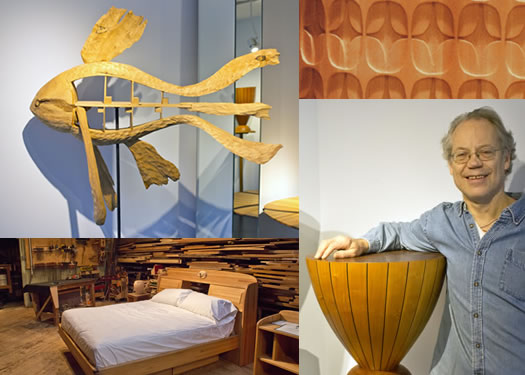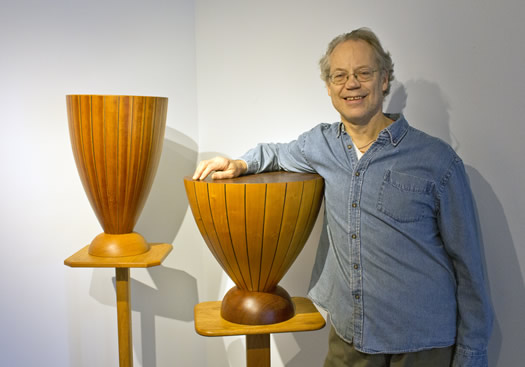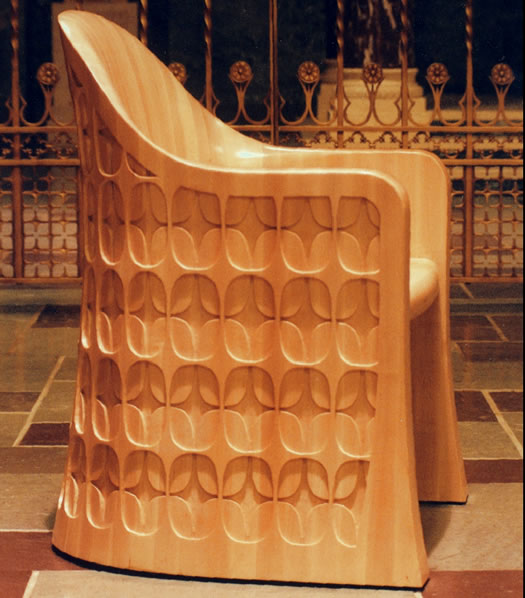Springwood Studios

Troy woodworker Jim Lewis has a spiritual and emotional connection to his work.
The self-taught craftsman has created furniture, liturgical pieces for churches around the United States, and sculptures over his four decade career. And he's continuing to evolve his work. Lewis recently re-introduced his 4th Street shop, Icarus Furniture, as Springwood Studios as part an effort to "go back to my roots and do things a little simpler and a little sweeter."
I chatted with Lewis about simplifying life and work, learning new skills, and doing the things you're supposed to be doing...

What got you started on woodworking and making art?
I was a pretty spacey kid, and I needed to ground myself. My dad was a very grounded guy. In the early 50s he and my mom bought a farm in Lancaster County, Pennsylvania. He was a foreman in a factory, and he spent all of his spare time working on the farm, because there's a million things to do to keep up a farm. It just kept him busy all the time. I came of age in the 60s, and there was such a gap between the generations. It was hard to communicate. I could talk to my mom, but not so easily to my dad, who spent most of his time making and building things. So I got involved in this, partly as a way to talk to him, because we had a common language. And there were several times that I decided to keep at it as a way to talk to him.
So I guess there's a lot for me in renaming it Springwood because it takes me back to when I was a kid playing in the woods. You know, I made a log cabin. I had three trees that were kind of my best friends because we were out in the country. (laughs) And it puts me back to all of that.

Were you pretty much self-taught, then?
Yeah, although I certainly had a lot of help along the way. There was an ironworker around the corner, and he taught me a lot about working with bigger stuff. He was the kind of guy who knew his process, which was different than mine, but he could come in and look at us working on a piece and know immediately what the problems were going to be. And I've found, over the years, I've sort of picked up that skill, too. You get a sense of what's is going to give you trouble and get a sense of where you're avoiding the issue. But in my work, I use a lot of processes that are designed for machine tools that were never used on wood, but I use them anyway. Because you think about it, and it makes sense to do it that way.
For instance, when I was doing St. Edward the Confessor church, we did some machining in solid wood. And the technique I used, later I found out that Antoni Gaudi had used it to make La Sagrada Familia church in Barcelona. And he was carving stone and I was carving wood. But when you think about the geometry, that's the way you do it.

A nautilus dome created for an EMPAC installation in 2004.
You opened this studio originally quite a while ago, how many years was it?
Well I was working for somebody else in '72. And we were making waterbeds. In '77 my partner and I bought it and changed the name to Icarus. And we broadened what we did. We were pretty much out of waterbeds. On a scale like this, they're not much fun to work with. I'd much rather do a platform bed. We did a lot more different types of home furnishings, occasionally a commercial piece, and every once in a while a church would come in and ask for something.

A chair created for the Maryknoll Fathers and Brothers in Ossining.
Then in the 90s, Troy was in pretty bad shape at that point. And I realized that I could no longer depend on people walking in the door or coming in from right around here. And I realized that I'd need something to be able to work with people at a distance. With a friend I thought about where I used to do the kind of work I wanted to do. And it seemed like churches and sacred furniture were the best one. It was a place where we could make a difference. It was a place where we could be known in a small community that talks to each other. But, most importantly, if it wasn't done right, it would be done wrong. It's not that pieces aren't designed, it's that they're designed by people that make choices for the wrong reasons. And we learned something about making choices for the right reasons and we were willing to put the time in.

Given that there have been a couple different changes in the studio's past, why did you decide to change the studio name again now?
I bought out my partner; actually it was a few years back. Because I was involved in my other project and I was renovating this place, I hadn't formally changed the name to the community or changed the sign.
We decided it was time to look at things in another way. And for me, coming back into the business, during a time when there was a lot of change and personal growth for me, and I needed to go back to my roots and do things a little simpler and a little sweeter, and a little more thoughtfully. I think that's true about us a lot of times. We think we're making big changes, but really we need to make little changes. And little changes in several areas add up to big changes in the way things look or the way things feel. So I'm doing things that have a little more meaning to me now.
At one point I had seven people working here, and it was very crowded and very hectic. And when you have that many people, they bump into each other and you're spending a lot of time looking into employment regulations and things like that. It gets to be a paperwork business. And if you're in it for the business, that's good. But if you're in it for the heart of it, not so much. I liked having a community working here, but I still have a community and I work with people outside of here.

Are you going to be changing the types of things that you're going to be working on?
A lot of that depends on what comes my way. I look for work, but you know, the things that come your way are often things that there's a reason for you to work on. And I believe in doing the things you're supposed to do. Sometimes you're needed in a church, and sometimes you're not needed in a church. And if you're not needed, it's not the place to be. If you're needed, then you really better be there. Because it's a two-way commitment. And that balances out so that people's needs get met.
I want to do more pieces that are large-scale sculptures. I enjoy making the forms a lot; I enjoy the process of making them.
So when you're making something for a client, what is the process? Is it collaborative?
It's all over the place. I was frustrated with what I was doing once. A guy came in with a cabinet that I couldn't build with my old process. And I already knew what the new process would be and I knew it would work perfectly. As I thought about his cabinet, I wanted to change something so it was my design. I realized that this is a gift, and I thanked him for it every time I've seen him. It was a perfectly designed cabinet and it gave me a new way of constructing things.
Most times, though, since I work with 3D, visual, and making things solid, I know much more about that process than they do. And I always take the information about what they're looking to do, and I add to it with what they're not seeing, that they need to do.

What is your favorite type of piece to work on?
I love doing sculpture and shaping things. When I was carving this piece, I was going into that state where I was falling in love with wood and was being absorbed in it. It was like communion with the Divine Mother. And I get that sometimes when I'm carving curved shapes. It's just a feeling of such oneness and love and respect and devotion. But I can't do that all the time. There's other times that I want things that are so plain and simple. And there's other times I want things that are majestic and visible to many at a time. Sometimes it's the intimacy of it, and sometimes it's the spontaneity. It goes all over, and that's what I love about wood. You wake up feeling one way and there's a way to work with wood to match it.
This interview has been condensed and lightly edited.
photos of Maryknoll chair and the nautilus dome courtesy of Jim Lewis.
Find It
Springwood Studios
154 4th Street
Troy, NY 12180
... said KGB about Drawing: What's something that brought you joy this year?